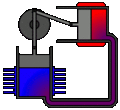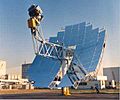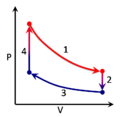Stirling engine facts for kids
A Stirling engine is a special kind of heat engine. It changes heat energy into useful movement, like turning a wheel. Imagine a piston moving inside a cylinder! That's how it works.
Unlike car engines (which are internal combustion engines) or old train engines (which are steam engines), a Stirling engine is different. It uses the same gas over and over again inside its cylinder. This means it's usually much quieter because there's no noisy exhaust gas being pushed out. The gas inside the engine just keeps getting heated and cooled, making the piston move.
To make it run, a Stirling engine needs a hot part and a cold part. The hot part gets its heat from somewhere like a fire, the sun's rays, hot rocks near a volcano, or even nuclear energy. The cold part is kept cool by air or water flowing over it. This difference in temperature is what makes the engine work!
This clever engine was invented a long time ago, in 1816, by a Scottish minister named Reverend Dr. Robert Stirling.
Contents
How a Stirling Engine Works
A Stirling engine works by using a sealed amount of gas, like air or helium, that is heated and cooled in a cycle.
The Basic Idea
Imagine a balloon. If you heat the air inside, the balloon gets bigger. If you cool it, it shrinks. A Stirling engine uses this same idea.
- When the gas inside the engine gets hot, it expands and pushes a piston. This creates power.
- When the gas moves to a cooler part of the engine, it cools down and shrinks. This allows the piston to move back, ready for the next push.
- The engine has a special part called a regenerator. This part helps to store heat from the gas as it moves from the hot side to the cold side, and then gives that heat back to the gas as it moves from the cold side to the hot side. This makes the engine more efficient.
Types of Stirling Engines
There are a few main ways Stirling engines are built:
- Alpha-type: This type has two separate cylinders. One is kept hot, and the other is kept cold. The gas moves between them.
- Beta-type: This engine has just one cylinder, but it's hot at one end and cold at the other. A special part called a 'displacer' moves the gas between the hot and cold parts.
- Gamma-type: Similar to the beta-type, but the power piston and displacer are in separate cylinders, though still connected.
- Free-piston Stirling engines: These engines don't have mechanical connections like crankshafts. The pistons move freely, driven by the gas pressure changes.
What Are Stirling Engines Used For?
Even though they were invented a long time ago, Stirling engines are still useful today!
Past Uses
In the past, Stirling engines were sometimes used for small tasks like pumping water or powering fans, especially in places where steam engines were too dangerous or complicated. They were also used in some early radios and generators.
Modern Uses
Today, Stirling engines are used in some interesting ways:
- Solar Power: They can be connected to large dish mirrors that focus the sun's rays to create very high temperatures. This heat then powers the Stirling engine to generate electricity.
- Combined Heat and Power (CHP): Some modern systems use Stirling engines to produce electricity and also capture the waste heat for heating buildings or water. This makes them very efficient.
- Submarines: Some non-nuclear submarines use Stirling engines because they are very quiet and can run on different types of fuel.
- Space Exploration: Because they can run on any heat source and are reliable, they've been considered for power generation in space missions.
Stirling engines are known for being quiet, reliable, and able to use many different heat sources, which makes them a fascinating part of engine technology!
Images for kids
-
Dish Stirling from SES
See also
 In Spanish: Motor Stirling para niños
In Spanish: Motor Stirling para niños













